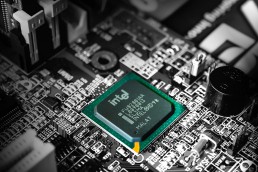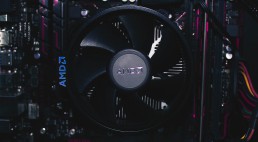Intel (INTC)
The Silicon Valley region of California’s Bay Area got its name in the 1960s as a result of the many semiconductor companies that were established in the area, making the silicon-based chips that were powering the computer revolution. At the forefront of this movement was Intel (INTC), a company founded by two of luminaries of information technology – Robert Noyce, the inventor of the integrated circuit, and Gordon Moore, the developer of “Moore’s law” of technological development – that emerged as an early leader in both SRAM and DRAM memory chips, as well as the x86 series of microprocessors that drove the vast majority of personal computers starting in the 1980s.
Today Intel continues to manufacture processors for mobile and desktop use, as well as computer hardware infrastructure like motherboards, network interface controllers, memory chips, graphics controllers and more. Intel’s primary competitor to this day is AMD, the number-two U.S. maker of integrated circuits.
In 2018, Intel reported more than $70 billion in revenue and employed more than 110,000 people in facilities all over the world.
Rationale
The most direct way to gain exposure to INTC is to buy its listed shares. But there are a number of good reasons for investors to reconsider that approach. As of 2018, Intel remains a world leader in semiconductor development and manufacturing. But it is starting to grip on the world market, recently losing its title of world’s largest semiconductor to South Korea’s Samsung Electronics. What’s more, as mobile computer begins to fully displace traditional desktop and laptop computers, there is less of a need for Intel’s specialized hardware. That pivot is only accelerating and could start to drag down Intel’s long-term growth.
However, rather than buying INTC shares themselves, investors interested in gaining exposure to the information technology and semiconductor sectors might consider buying funds that provide exposure to Intel and its competitors. After all, the return drivers that will benefit INTC might also benefit other similar companies in information technology, computing, and semiconductor manufacturing. As investment management is gradually moving to the construction of portfolios using ETFs and mutual funds in addition to single stocks, investors would do well to consider gain exposure to firms like INTC through these types of funds.
Investing in INTC
A search on Magnifi suggests that investors can gain access to INTC via a number of different funds and ETFs, including those shown below.
Schedule a demo and unlock
a 14-day free trial of Magnifi Pro+
Magnifi is changing the way we shop for investments, with the world’s first semantic search engine for finance that helps users discover, compare and buy investment products such as ETFs, mutual funds and stocks. Try it for yourself today.
This blog is sponsored by Magnifi. The information and data are as of the publish date unless otherwise noted and subject to change. This material is provided for informational purposes only and should not be construed as individualized investment advice or an offer or solicitation to buy or sell securities tailored to your needs. This information covers investment and market activity, industry or sector trends, or other broad-based economic or market conditions and should not be construed as investment research or advice. Investors are urged to consult with their financial advisors before buying or selling any securities. Although certain information has been obtained from sources believed to be reliable, we do not guarantee its accuracy, completeness or fairness. Past performance is no guarantee of future results. This content may not be reproduced or distributed to any person in whole or in part without the prior written consent of Magnifi. [As a technology company, Magnifi provides access to tools and will be compensated for providing such access. Magnifi does not provide broker-dealer, custodian, investment advice or related investment services.]
IBM (IBM)
Few companies have been as successful at reinventing themselves and their businesses over the years as IBM(IBM), which got its start as International Business Machines in the first half of the 20th century, selling early computing machines, eventually expanding out to include mainframes, personal computers and more. It is also a major research organization, holding the record for more U.S. patents generated by a business for the last 26 years, including such innovations as the ATM machine, floppy disk, UPC barcode, magnetic stripe reader and more.
Today IBM develops computer hardware and software, offers business consulting services, cloud computing services and more. Its subsidiaries include PwC Consulting, The Weather Company and Red Hat, a maker of open-source software.
IBM currently employs more than 350,000 people across 170 countries and its revenue for 2018 was $79.5 billion.
Rationale
The most direct way to gain exposure to IBM is to buy its listed shares. But there are a number of good reasons for investors to reconsider that approach. As a multinational conglomerate in the large and competitive information technology industry, IBM must continually innovate in order to stay ahead of the ever-evolving market for computer technology and services. What’s more, IBM has gone through a number of different evolutions in recent decades – most notably a pivot to consulting services in the 2000s – in order to remain competitive. It has done well so far, but longevity in such a competitive space is never guaranteed.
However, rather than buying IBM shares themselves, investors interested in gaining exposure to the information technology sector might consider buying funds that provide exposure to IBM and its competitors. After all, the return drivers that will benefit IBM might also benefit other similar companies in information technology, computing, and business consulting. As investment management is gradually moving to the construction of portfolios using ETFs and mutual funds in addition to single stocks, investors would do well to consider gain exposure to firms like IBM through these types of funds.
Investing in IBM
A search on Magnifi suggests that investors can gain access to IBM via a number of different funds and ETFs, including those shown below.
Schedule a demo and unlock
a 14-day free trial of Magnifi Pro+
Magnifi is changing the way we shop for investments, with the world’s first semantic search engine for finance that helps users discover, compare and buy investment products such as ETFs, mutual funds and stocks. Try it for yourself today.
This blog is sponsored by Magnifi. The information and data are as of the publish date unless otherwise noted and subject to change. This material is provided for informational purposes only and should not be construed as individualized investment advice or an offer or solicitation to buy or sell securities tailored to your needs. This information covers investment and market activity, industry or sector trends, or other broad-based economic or market conditions and should not be construed as investment research or advice. Investors are urged to consult with their financial advisors before buying or selling any securities. Although certain information has been obtained from sources believed to be reliable, we do not guarantee its accuracy, completeness or fairness. Past performance is no guarantee of future results. This content may not be reproduced or distributed to any person in whole or in part without the prior written consent of Magnifi. [As a technology company, Magnifi provides access to tools and will be compensated for providing such access. Magnifi does not provide broker-dealer, custodian, investment advice or related investment services.]
General Electric (GE)
It’s been a long and winding road for General Electric (GE), one of the first 12 companies to be included as part of the Dow Jones Industrial Average when the list was first launched in 1896. Founded by none other than Thomas Edison, who created the Edison Lamp Company in the late 1880s to market his newest innovation, the electric lightbulb, GE as a company was formed in 1889 by Edison’s financial backers, including J.P. Morgan and the Verderbilt family, as a way to support all of the various applications for electricity that were emerging at the time. In the early days, those applications included everything from railroads, to radio, to power generation and more.
Today GE is one of the largest conglomerates in the world, with interests in aviation, healthcare, renewable energy, additive manufacturing, financial services and, of course, electric lighting.
For 2018, GE’s worldwide revenue was more than $121 billion, placing it 18th on the Fortune 500 list of the largest U.S. companies by revenue. It employs more than 230,000 people across 130 countries.
Rationale
For more than a century, the most direct way to gain exposure to General Electric has been to buy its listed shares. But lately there have been a number of good reasons for investors to reconsider that approach. For one thing, GE was delisted from the Dow Jones Industrial Average in 2018 after its enterprise value was nearly cut in half in 2017 following years of disappointing financial results. Between 2016 and 2018, the company lost 74% of its market cap, due in large part to bad moves in its power generation business.
However, investors interested in gaining exposure to the sectors that General Electric competes, rather than buying GE shares themselves should consider buying funds that provide exposure to General Electric and other conglomerates. After all, the return drivers that will benefit GE might also benefit other similar companies in aviation, manufacturing, consumer staples and more. As investment management is gradually moving to the construction of portfolios using ETFs and mutual funds in addition to single stocks, investors would do well to consider gain exposure to firms like General Electric through these types of funds.
Investing in GE
A search on Magnifi suggests that investors can gain access to GE via a number of different funds and ETFs, including those shown below.
Schedule a demo and unlock
a 14-day free trial of Magnifi Pro+
Magnifi is changing the way we shop for investments, with the world’s first semantic search engine for finance that helps users discover, compare and buy investment products such as ETFs, mutual funds and stocks. Open a Magnifi investment account today.
This blog is sponsored by Magnifi. The information and data are as of the publish date unless otherwise noted and subject to change. This material is provided for informational purposes only and should not be construed as individualized investment advice or an offer or solicitation to buy or sell securities tailored to your needs. This information covers investment and market activity, industry or sector trends, or other broad-based economic or market conditions and should not be construed as investment research or advice. Investors are urged to consult with their financial advisors before buying or selling any securities. Although certain information has been obtained from sources believed to be reliable, we do not guarantee its accuracy, completeness or fairness. Past performance is no guarantee of future results. This content may not be reproduced or distributed to any person in whole or in part without the prior written consent of Magnifi. [As a technology company, Magnifi provides access to tools and will be compensated for providing such access. Magnifi does not provide broker-dealer, custodian, investment advice or related investment services.]
Netflix (NFLX)
It wasn’t long ago that in-home entertainment was limited to whatever was on broadcast TV or what was available at your local video rental store. That all changed in 1997, when Netflix (NFLX) came on the scene, offering a new DVD-rental-by-mail service that eliminated the drive to the video store and opened up a vast library of new and old titles to subscribers for a flat monthly fee. In 2010, Netflix took things a step further, introducing a new streaming media service that, for a flat monthly fee, would allow customers to directly stream content to their homes without having to even get up off the couch.
Today Netflix operates a trio of businesses: it’s streaming services, DVD and Blu-ray rental by mail, as well a production and distribution for its own series of films and television series. As of 2019, the company had more than 60 million paid subscriptions in the U.S. and a total of 148 million worldwide, where it is currently available in just about every country.
Netflix reported nearly $16 billion in revenue for 2018 and currently employs about 5,400 people in its offices around the world.
Rationale
As one of the so-called “FANG” stocks – a list that also includes high-growth stocks like Facebook, Amazon and Google – Netflix has been a darling of many investors in recent years. The most direct way to gain exposure to Netflix is to buy its listed shares, of course, but there are reasons for investors to reconsider that approach, despite its popularity. For one thing, Netflix’s rapid expansion is beginning to slow now that it is available worldwide. It is simply running out of new customers to fuel its growth. What’s more, the company’s push to produce new content and secure rights for existing content around the world has been piling it under a mountain of debt, more than $21 billion as of 2017. That debt load will eventually serve as a drag on its upside potential.
However, for investors interested in gaining exposure to the streaming media sector, rather than buying NFLX shares themselves should consider buying funds that provide exposure to Netflix and other media firms like CBS, HBO and others. After all, the return drivers that will benefit NFLX might also benefit other similar companies. As investment management is gradually moving to the construction of portfolios using ETFs and mutual funds in addition to single stocks, investors would do well to consider gain exposure to firms like Netflix through these types of funds.
Investing in NFLX
A search on Magnifi suggests that investors can gain access to Netflix via a number of different funds and ETFs, including those shown below.
Schedule a demo and unlock
a 14-day free trial of Magnifi Pro+
Magnifi is changing the way we shop for investments, with the world’s first semantic search engine for finance that helps users discover, compare and buy investment products such as ETFs, mutual funds and stocks. Try it for yourself today.
This blog is sponsored by Magnifi. The information and data are as of the publish date unless otherwise noted and subject to change. This material is provided for informational purposes only and should not be construed as individualized investment advice or an offer or solicitation to buy or sell securities tailored to your needs. This information covers investment and market activity, industry or sector trends, or other broad-based economic or market conditions and should not be construed as investment research or advice. Investors are urged to consult with their financial advisors before buying or selling any securities. Although certain information has been obtained from sources believed to be reliable, we do not guarantee its accuracy, completeness or fairness. Past performance is no guarantee of future results. This content may not be reproduced or distributed to any person in whole or in part without the prior written consent of Magnifi. [As a technology company, Magnifi provides access to tools and will be compensated for providing such access. Magnifi does not provide broker-dealer, custodian, investment advice or related investment services.]
Dish Network (DISH)
Cable television revolutionized entertainment in the 1950s and 60s, delivering television directly to users via a dedicated cable rather than relying on weak broadcast service, resulting in better quality and access to far more content. Then, in the 1980s and 90s, satellite television technology took it a step further, beaming content directly to viewers via satellite, expanding the service footprint that cable cannot reach. Founded in 1996, Dish Network (DISH) is today one of the largest direct-broadcast satellite providers in the U.S., also offering over-the-top service via its subsidiary Sling TV.
The company got its start in 1980 as EchoStar Communications Corporation, which distributed satellite television equipment, and didn’t get into satellite service until 1995 when it launched its first satellite, EchoStar I. As of 2018, Dish Network had roughly 17,000 employees and roughly 9.9 million customers. Its revenue for the most recent year were $13.6 billion.
Rationale
The most direct way to gain exposure to Dish Network is to buy its listed shares, of course, but there are reasons for investors to reconsider that approach. Like many companies in the television services business, DISH is currently losing customers at a rapid pace due to the ongoing cord-cutting trend, which is seeing subscribers cancel their pay-TV subscriptions in favor of direct and internet streaming entertainment options. Dish in particular lost 381,000 subscribers in Q4 2018, and more than five million in total since 2014.
However, for investors interested in gaining exposure to the television sector, rather than buying DISH shares themselves should consider buying funds that provide exposure to Dish Network and other communications firms like AT&T’s DirecTV and cable providers. After all, the return drivers that will benefit DISH might also benefit other similar companies. As investment management is gradually moving to the construction of portfolios using ETFs and mutual funds in addition to single stocks, investors would do well to consider gain exposure to firms like Dish Network through these types of funds.
Investing in DISH
A search on Magnifi suggests that investors can gain access to Dish Network via a number of different funds and ETFs, including those shown below.
Schedule a demo and unlock
a 14-day free trial of Magnifi Pro+
Magnifi is changing the way we shop for investments, with the world’s first semantic search engine for finance that helps users discover, compare and buy investment products such as ETFs, mutual funds and stocks. Open a Magnifi investment account today.
This blog is sponsored by Magnifi. The information and data are as of the publish date unless otherwise noted and subject to change. This material is provided for informational purposes only and should not be construed as individualized investment advice or an offer or solicitation to buy or sell securities tailored to your needs. This information covers investment and market activity, industry or sector trends, or other broad-based economic or market conditions and should not be construed as investment research or advice. Investors are urged to consult with their financial advisors before buying or selling any securities. Although certain information has been obtained from sources believed to be reliable, we do not guarantee its accuracy, completeness or fairness. Past performance is no guarantee of future results. This content may not be reproduced or distributed to any person in whole or in part without the prior written consent of Magnifi. [As a technology company, Magnifi provides access to tools and will be compensated for providing such access. Magnifi does not provide broker-dealer, custodian, investment advice or related investment services.]
Bank of America (BAC)
Despite its name, Bank of America (BAC) actually isn’t the largest bank in the United States. That honor actually goes to JPMorgan Chase, which has $2.74 trillion in assets. Bank of America is number two, with $2.38 trillion, as of 2018, making it the eighth largest bank in the world. And, despite its name today, it traces its roots back to two divergent banks – Bank of Massachusetts on the east coast, founded in 1784, and Bank of Italy, a San Francisco-based bank for Italian immigrants, founded in 1904.
The bank as it’s known today was formed in 1998 after the merger of NationsBank and BankAmerica, and it is today part of the Big Four of U.S. banks, serving more than 10% of all American deposits and offering services in commercial banking, retail banking, wealth management and investment banking. Its subsidiaries include Merrill Lynch and it operates branches in all 50 U.S. states, more than 15,000 ATMs machines and serves more than 46 million customers.
Bank of America’s market cap is $296 billion as of 2019, and it generated more than $91 billion in revenue in 2018.
Rationale
The most direct way to gain exposure to Bank of America is to buy its listed shares, of course, but there are reasons for investors to reconsider that approach. As a bulge bracket bank, BAC operates in a highly regulated space, subject to ongoing government oversight and scrutiny. This helps to protect its customers and other participants in the financial system from loss due to corporate misdeeds, but limits BAC’s potential for growth as a business itself. What’s more, Bank of America received a bailout during the 2008 financial crisis, highlighting its susceptibility to worldwide financial problems that have not entirely gone away in the years since.
However, for investors interested in gaining exposure to the banking sector, rather than buying BAC shares themselves should consider buying funds that provide exposure to Bank of America and other financial services firms. After all, the return drivers that will benefit BAC might also benefit other similar banks. As investment management is gradually moving to the construction of portfolios using ETFs and mutual funds in addition to single stocks, investors would do well to consider gain exposure to firms like Bank of America through these types of funds.
Investing in BAC
A search on Magnifi suggests that investors can gain access to Bank of America via a number of different funds and ETFs, including those shown below.
Schedule a demo and unlock
a 14-day free trial of Magnifi Pro+
Magnifi is changing the way we shop for investments, with the world’s first semantic search engine for finance that helps users discover, compare and buy investment products such as ETFs, mutual funds and stocks. Try it for yourself today.
This blog is sponsored by Magnifi. The information and data are as of the publish date unless otherwise noted and subject to change. This material is provided for informational purposes only and should not be construed as individualized investment advice or an offer or solicitation to buy or sell securities tailored to your needs. This information covers investment and market activity, industry or sector trends, or other broad-based economic or market conditions and should not be construed as investment research or advice. Investors are urged to consult with their financial advisors before buying or selling any securities. Although certain information has been obtained from sources believed to be reliable, we do not guarantee its accuracy, completeness or fairness. Past performance is no guarantee of future results. This content may not be reproduced or distributed to any person in whole or in part without the prior written consent of Magnifi. [As a technology company, Magnifi provides access to tools and will be compensated for providing such access. Magnifi does not provide broker-dealer, custodian, investment advice or related investment services.]
Nvidia (NVDA)
Nvidia (NVDA) isn’t a household name for many people, but that doesn’t mean the company hasn’t had a massive impact on the daily lives of billions of people around the world. Nvidia’s founders invented what is known as the graphics processing unit (GPU), creating the company in 1993, and today it creates interactive graphics on laptops, workstations, mobile devices, notebooks, PCs, and more. It is active in the video gaming market and develops advanced graphic processing products for both commercial and wholesale usage.
Nvidia’s business is broken down into 4 silos: gaming, professional visualization, data centers and automotive. The company is now also working on technologies including parallel processing, artificial intelligence, mobile computing and more.
In 2018, NVDA’s revenue was $11.72 billion and it’s market cap as of 2019 is $129 billion.
Rationale
All that said, there are reasons for investors to think twice about investing directly in NVDA. The most direct way to gain exposure to Nvidia is to buy its listed shares, of course, but its participation in the extremely competitive computer hardware market might make many reconsider that approach. Companies like NVDA must constantly innovate and find new ways to drive revenue as both technologies and consumer needs change and evolve. What’s more, new applications for GPUs, such as for cryptocurrency mining, are rapidly expanding Nvidia’s potential market and opening it up to new competition that’s more focused on those opportunities.
However, for investors interested in gaining exposure to the computing hardware sector, rather than buying NVDA shares themselves should consider buying funds that provide exposure to Nvidia and other similar firms. After all, the return drivers that will benefit NVDA might also benefit other similar tech firms. As investment management is gradually moving to the construction of portfolios using ETFs and mutual funds in addition to single stocks, investors would do well to consider gain exposure to firms like Nvidia through these types of funds.
Investing in NVDA
A search on Magnifi suggests that investors can gain access to Nvidia via a number of different funds and ETFs, including those shown below.
Schedule a demo and unlock
a 14-day free trial of Magnifi Pro+
Magnifi is changing the way we shop for investments, with the world’s first semantic search engine for finance that helps users discover, compare and buy investment products such as ETFs, mutual funds and stocks. Try it for yourself today.
This blog is sponsored by Magnifi. The information and data are as of the publish date unless otherwise noted and subject to change. This material is provided for informational purposes only and should not be construed as individualized investment advice or an offer or solicitation to buy or sell securities tailored to your needs. This information covers investment and market activity, industry or sector trends, or other broad-based economic or market conditions and should not be construed as investment research or advice. Investors are urged to consult with their financial advisors before buying or selling any securities. Although certain information has been obtained from sources believed to be reliable, we do not guarantee its accuracy, completeness or fairness. Past performance is no guarantee of future results. This content may not be reproduced or distributed to any person in whole or in part without the prior written consent of Magnifi. [As a technology company, Magnifi provides access to tools and will be compensated for providing such access. Magnifi does not provide broker-dealer, custodian, investment advice or related investment services.]
Gap (GPS)
A mainstay of malls and shopping centers across the U.S. in the 1990s, Gap Inc. (GPS) is today a clothing and accessories retailer with operations around the world. Founded as a jeans shop in San Francisco in 1969, Gap today sells a wide variety of products for men, women and children, including sportswear, activewear, and more.
The company’s six primary divisions include retail outlets The Gap, upscale store Banana Republic, discount retailer Old Navy, fitness wear brand Athleta, curated fashion site Intermix, and Hill City, a maker of performance menswear.
As of 2018, Gap’s revenue was $16.6 billion and it was the largest specialty retailer in the U.S. It currently operates more than 3,700 stores worldwide, more than 60% of which are in North America.
Rationale
The most direct way to gain exposure to Gap is to buy its listed shares, of course, but its participation in the extremely competitive retail and fashion markets might make many reconsider that approach. Companies like GPS have to stay ahead of the constantly shifting trends in fashion in order to remain competitive in the marketplace. What’s more, Gap’s reliance on mall and shopping center locations puts it at risk as consumer choice moves away from brick and mortar shopping to more online purchases.
However, for investors interested in gaining exposure to the retail and consumer spending sector, rather than buying GPS shares themselves should consider buying funds that provide exposure to Gap and other similar firms. After all, the return drivers that will benefit GPS might also benefit other similar retail firms. As investment management is gradually moving to the construction of portfolios using ETFs and mutual funds in addition to single stocks, investors would do well to consider gain exposure to firms like Gap through these types of funds.
Investing in GPS
A search on Magnifi suggests that investors can gain access to GPS via a number of different funds and ETFs, including those shown below.
Schedule a demo and unlock
a 14-day free trial of Magnifi Pro+
Magnifi is changing the way we shop for investments, with the world’s first semantic search engine for finance that helps users discover, compare and buy investment products such as ETFs, mutual funds and stocks. Try it for yourself today.
This blog is sponsored by Magnifi. The information and data are as of the publish date unless otherwise noted and subject to change. This material is provided for informational purposes only and should not be construed as individualized investment advice or an offer or solicitation to buy or sell securities tailored to your needs. This information covers investment and market activity, industry or sector trends, or other broad-based economic or market conditions and should not be construed as investment research or advice. Investors are urged to consult with their financial advisors before buying or selling any securities. Although certain information has been obtained from sources believed to be reliable, we do not guarantee its accuracy, completeness or fairness. Past performance is no guarantee of future results. This content may not be reproduced or distributed to any person in whole or in part without the prior written consent of Magnifi. [As a technology company, Magnifi provides access to tools and will be compensated for providing such access. Magnifi does not provide broker-dealer, custodian, investment advice or related investment services.]
Advanced Micro Devices (AMD)
Advanced Micro Devices (AMD) isn’t a household name for many people, but that doesn’t mean the company hasn’t has a massive impact on the daily lives of billions of people around the world. AMD is the second-largest supplier of microprocessors in the world, behind only Intel (INTC) in terms of market reach, and today is produces a wide range of microprocessor chips (for computers as well as mobile devices), motherboard chipsets, embedded processors and graphics processors for services, workstations, personal computers, mobile devices and more.
It’s also active in the market for graphics processes after acquiring ATI in 2006. Today it is number-two in graphics process unit sales after only Nvidia (NVDA). In 2018, AMD’s revenue was $6.48 billion and its market cap was about $45 billion.
Rationale
All that said, there are reasons for investors to think twice about investing directly in AMD. The most direct way to gain exposure to Advanced Micro Devices is to buy its listed shares, of course, but its participation in the extremely competitive computer hardware market might make many reconsider that approach. Companies like AMD must constantly innovate and find new ways to drive revenue as both technologies and consumer needs change and evolve. This can be extremely lucrative for those can stay ahead of the trends, but those fortunes can change quickly when a new technology or need is overlooked or claimed by a competitor. What’s more, as the number-two competitor in both of its primary markets – microprocessors (behind Intel) and graphics processing units (behind Nvidia) – Advanced Micro Devices is at the mercy of its larger competitors and is often forced to compete on price rather than its own innovations.
However, for investors interested in gaining exposure to the microprocessing sector, rather than buying AMD shares themselves should consider buying funds that provide exposure to Advanced Micro Devices and other similar firms. After all, the return drivers that will benefit AMD might also benefit other similar tech firms. As investment management is gradually moving to the construction of portfolios using ETFs and mutual funds in addition to single stocks, investors would do well to consider gain exposure to firms like Advanced Micro Devices through these types of funds.
Investing in AMD
A search on Magnifi suggests that investors can gain access to AMD via a number of different funds and ETFs, including those shown below.
Schedule a demo and unlock
a 14-day free trial of Magnifi Pro+
Magnifi is changing the way we shop for investments, with the world’s first semantic search engine for finance that helps users discover, compare and buy investment products such as ETFs, mutual funds and stocks. Try it for yourself today.
This blog is sponsored by Magnifi. The information and data are as of the publish date unless otherwise noted and subject to change. This material is provided for informational purposes only and should not be construed as individualized investment advice or an offer or solicitation to buy or sell securities tailored to your needs. This information covers investment and market activity, industry or sector trends, or other broad-based economic or market conditions and should not be construed as investment research or advice. Investors are urged to consult with their financial advisors before buying or selling any securities. Although certain information has been obtained from sources believed to be reliable, we do not guarantee its accuracy, completeness or fairness. Past performance is no guarantee of future results. This content may not be reproduced or distributed to any person in whole or in part without the prior written consent of Magnifi. [As a technology company, Magnifi provides access to tools and will be compensated for providing such access. Magnifi does not provide broker-dealer, custodian, investment advice or related investment services.]
Microsoft (MSFT)
When your cofounder and former CEO is regularly in the mix for richest person in the world, you know the company they founded is going to be a huge one, and Microsoft (MSFT) lives up to the billing. Founded by Gates and his business partner, Paul Allen, in Albuquerque, NM in 1975 as a software company focused on BASIC applications, Microsoft later moved to the Seattle suburbs and has become synonymous with personal computing and software ever since.
Today Microsoft sells computer software, consumer electronics, personal computers, cloud computing and a wide range of related products and surfaces, including the Microsoft Office software package, Windows operating system, Xbox video game consoles, and the Microsoft Surface table computer. It is the world’s largest software company by revenue, and also owns social networking site LinkedIn as well as online communications provider Skype.
As of 2019, Microsoft is the world’s most valuable company, with a market cap of $1.14 trillion and fiscal year 2019 revenues of $125 billion.
Rationale
The most direct way to gain exposure to Microsoft is to buy its listed shares. But investors have good reason to reconsider that approach given Microsoft’s participation in the extremely competitive and trend-focused personal computing market. Companies like Microsoft must constantly innovate and find new ways to drive revenue as both technologies and consumer needs change and evolve. This can be extremely lucrative for those can stay ahead of the trends, but those fortunes can change quickly when a new technology or need is overlooked or claimed by a competitor.
However, for investors interested in gaining exposure to the software sector, rather than buying MSFT shares themselves should consider buying funds that provide exposure to Microsoft and other similar firms. After all, the return drivers that will benefit MSFT might also benefit other similar tech firms. As investment management is gradually moving to the construction of portfolios using ETFs and mutual funds in addition to single stocks, investors would do well to consider gain exposure to firms like Microsoft through these types of funds.
Investing in MSFT
A search on Magnifi suggests that investors can gain access to Microsoft via a number of different funds and ETFs, including those shown above.
Schedule a demo and unlock
a 14-day free trial of Magnifi Pro+
Magnifi is changing the way we shop for investments, with the world’s first semantic search engine for finance that helps users discover, compare and buy investment products such as ETFs, mutual funds and stocks. Try it for yourself today.
This blog is sponsored by Magnifi. The information and data are as of the publish date unless otherwise noted and subject to change. This material is provided for informational purposes only and should not be construed as individualized investment advice or an offer or solicitation to buy or sell securities tailored to your needs. This information covers investment and market activity, industry or sector trends, or other broad-based economic or market conditions and should not be construed as investment research or advice. Investors are urged to consult with their financial advisors before buying or selling any securities. Although certain information has been obtained from sources believed to be reliable, we do not guarantee its accuracy, completeness or fairness. Past performance is no guarantee of future results. This content may not be reproduced or distributed to any person in whole or in part without the prior written consent of Magnifi. [As a technology company, Magnifi provides access to tools and will be compensated for providing such access. Magnifi does not provide broker-dealer, custodian, investment advice or related investment services.]









